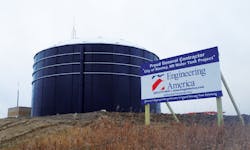About the author: Debbie Keuhn is a copywriter and the founder of Keuhn Creative. Keuhn can be reached at [email protected] or 612.386.2152.
Oil booms can provide great benefits to the communities involved in them, but they also can put a great burden on the aging or inadequate infrastructures of nearby cities, towns and rural systems.
The North Dakota oil boom that took off in the northwestern part of the state in 2011 brought many of these benefits to the city of Stanley, which is located just 68 miles from Williston, the nexus of the oil activity. However, Stanley’s water supply and distribution system needed to be updated to handle a population that would soon more than double.
Keeping Up With Growth
To deal with this increased demand for water in Stanley and surrounding rural areas, legislators established the Western Area Water Supply Authority (WAWSA), which now serves approximately 70,000 customers with water from the Missouri River.
“The dramatic population growth the region has seen in the past six to eight years forced us to increase the size of the pipeline that was feeding the cities of Stanley and Ross,” said Jaret Wirtz, executive director of WAWSA, who has been leading the utility since its inception. “With the oil boom bringing more people into the cities, coupled with new distribution systems providing water out to rural residents, a larger storage reservoir was needed.” The result was the construction of a 1-million-gal glass-fused-to-steel water tank from Engineering America.
Key Criteria in Tank Selection
“We were looking at two main criteria in selecting the tank. One was that it had to be a quality product, and our design company has had lots of experience and success putting up Engineering America’s glass-fused-to-steel tanks,” said Cory Chorne, project manager for AE2S, the engineering firm with which WAWSA worked. “The other was that the solution had to be economical. Those two things were really the drivers behind the type of tank we selected.”
The glass-fused-to-steel tank met the criteria AE2S had specified due to its low-maintenance, high-durability porcelain enamel coating. Chorne said these features are what make the tank economical. Corrosion issues can occur when using steel for water storage reservoirs.
Engineering America’s factory coats the steel with a long-lasting, glass-fused-to-steel coating system that is fired to achieve a robust protective coating for the steel.
“A lot of testing is done in the manufacturing facility, so you’ve got good quality control on the manufacturing and coating process before the panels are shipped out and bolted together on site, versus other steel tanks that are welded and painted in the field,” Chorne said. “That makes quality much harder to control.”
“The glass coating was definitely a consideration in choosing the tank,” said Todd Pokrzywinski, WAWSA operations manager, who noted that the high plains of North Dakota can experience fierce weather during certain seasons.
The factory-applied silica glass coating on the glass-fused-to-steel tank forms a hard, inert barrier for both the interior and exterior tank surfaces, which protects against weather conditions and corrosion. The coating is impermeable to liquids and vapors, controls undercutting caused by corrosion, and offers impact and abrasion resistance.
Smooth & Seamless
“We also liked the ability to build the tank in a short amount of time,” Pokrzywinski said. “We could build it in one construction season and have it online right away.”
Tank design began in 2015, and it was constructed and put into service in December 2016. “It was a very organized, well-run process,” Wirtz said of the construction. “From start to finish, the communication was great.”
Wirtz said the installation has received many positive comments from the residents in the community, especially from the several hundred rural water users who are excited about having higher-quality water for drinking, cooking, and washing dishes and clothes. “Getting the needed water out to the rural residents has been a huge challenge, and Engineering America’s tank was an integral part of the infrastructure needed to achieve that goal,” Wirtz said.
On the Same Page
“Like anything, a project of this magnitude takes teamwork and a well executed plan, and having all parties on the same page is essential,” Pokrzywinski said. “We worked well with everyone involved, starting with the landowners who gave us access to the overall tank design, experience with Engineering America and [its] tank product, and seamless transition to this aboveground tank.” “Having proper interaction between all parties helped us have open communication about our needs and our time frame, which is what you need to make a project succeed,” Wirtz said. “We really liked the cost-effectiveness of this project,” Chorne said. “But to me, the most successful part of this project was that it ended up being routine. And being routine is an engineer’s dream.”
